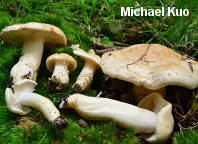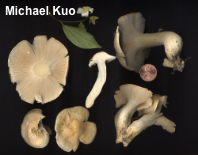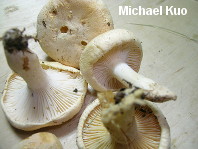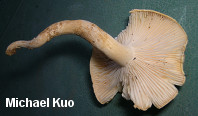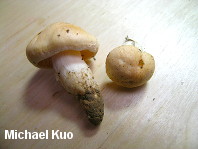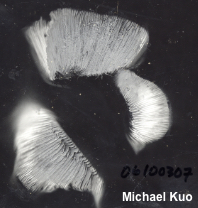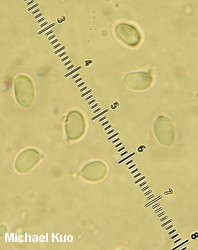| Major Groups > Gilled Mushrooms > Pale-Spored > Waxy Caps > Hygrophorus poetarum |

|
Hygrophorus poetarum [ Basidiomycota > Agaricales > Hygrophoraceae > Hygrophorus . . . ] by Michael Kuo Hygrophorus poetarum is an interesting waxy cap in the Hygrophorus pudorinus species group. Like other species in the group, it features pale pinkish orange colors, a yellow reaction to KOH, and a mealy stem apex. However, it can be separated on the basis of its association with hardwoods (especially beech), its strong, sickly sweet odor, and its small spores. In my area (central Illinois) it is quite common in late spring and early summer, and is one of the first mycorrhizal species to appear. Whether or not the North American version of Hygrophorus poetarum is phylogenetically the same as the original, European species, will depend on an extensive, DNA-based study of this species group. I suspect that many many "Hygrophorus pudorinus" collections in North American herbaria for which ecological data is lacking or insufficient ("on the ground in mixed woods," etc.) may have been made under hardwoods and have never-examined small spores, making them better matches for Hygrophorus poetarum; in a casual search of online herbarium records I find several good candidates, based on the vernal appearance and the hardwood habitat. Description: Ecology: Mycorrhizal with beech, oaks, and other hardwoods; growing alone, scattered or gregariously, often in moss; usually appearing in late spring or early summer, but occasionally found in late summer or fall; originally described from France and Switzerland; fairly widespread in Europe; North American distribution uncertain. The illustrated and described collections are from Illinois and Indiana. Cap: 2.5–8 cm; convex when young, becoming broadly convex or nearly flat; sticky when fresh, but usually drying out very quickly; bald, or finely hairy over the center; smooth, but with maturity often developing small pock marks; the margin at first inrolled, cottony, and soft, but eventually unrolling; pale pastel orange or, when growing in direct sunlight, orangish buff. Gills: Broadly attached to the stem or beginning to run down it; close or nearly distant; creamy white or, in age, very pale orange; short-gills frequent. Stem: 4–10 cm long; 1–3 cm thick; usually tapering to the base, and often developing a rooting portion underground; mealy at the apex, but bald or finely silky below; whitish to pale orange, discoloring a little orangish or brownish with age or when handled; white at the base; solid. Flesh: White; firm; unchanging when sliced. Odor and Taste: Odor usually strongly sweet and unpleasant (sometimes reminiscent of the "coal tar" odor in some species of Tricholoma) but occasionally weak, or merely faintly mealy; taste not distinctive. Chemical Reactions: KOH yellow to greenish yellow on cap surface; negative on stem apex but negative to yellow or greenish yellow on the stem base. Spore Print: White. Microscopic Features: Spores 5–7 x 3–4.5 µm; ellipsoid to sublacrymoid, with a prominent apiculus; smooth; hyaline in KOH; inamyloid. Basidia REFERENCES: R. Heim, 1948. (Arnolds, 1990; Breitenbach & Kränzlin, 1991; Canduso, 1997; Nonis, 2007; Lodge et al., 2013; Kovalenko, 2018; Læssøe & Petersen, 2019; Kibby, 2020.) Herb. Kuo 06100307, 06220805, 07250803, 06140902, 05291003, 05291004, 10101204, 06041306. This website contains no information about the edibility or toxicity of mushrooms. |
© MushroomExpert.Com |
|
Cite this page as: Kuo, M. (2022, March). Hygrophorus poetarum. Retrieved from the MushroomExpert.Com Web site: http://www.mushroomexpert.com/hygrophorus_poetarum.html |
